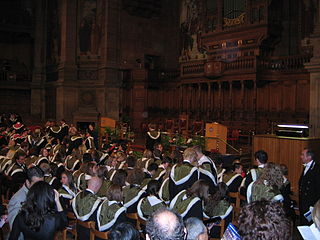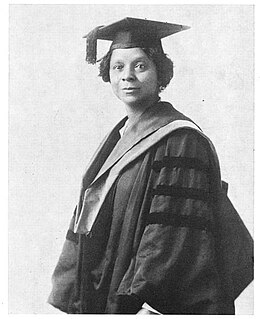
The University of Oxford has a long tradition of academic dress, which continues to the present day.

The academic dress of Durham University has many similarities with that of other older British universities such as Oxford and Cambridge. Most colleges of Durham University insist on gowns being worn on formal occasions, including matriculation and formal halls (dinners); exceptions are Van Mildert, St Cuthbert's Society, Collingwood, Stephenson, St Aidans, and The College of St Hild and St Bede. Some colleges also insist on their being worn to Junior Common Room meetings, and they are often seen in college chapels. At formal halls, only gowns are worn and doctors normally wear their undress gowns; for more ceremonial occasions full-dress gowns and hoods are worn by graduates. Until 1990, the General Regulations of University 'recommended' the wearing of gowns by members of the University when attending divine service at the Cathedral – but this is now left to individual choice apart from at certain services. Gowns are also customarily worn to meetings of the university Senate by members of that body.
The academic dress prescribed by the University of Bristol is a mixture of that prescribed by Cambridge and Oxford. Bristol has chosen, for graduates, to mainly specify Oxford-style gowns and Cambridge-style hoods. Unlike many British universities, the hood itself is to be "University red", lined with a specified colour. University red is defined to be Pantone 187. Bristol also specifies that undergraduates are to wear gowns "of the approved pattern" in certain circumstances, although the pattern itself is not specified. This is not too important since, in practice, undergraduates are never required to be gowned except when graduating.

In general, the academic dress of the University of Nottingham dates from the award of its Royal Charter in 1948. Prior to this date, University College, Nottingham taught students for University of London examinations and "Nottingham graduates" were actually London graduates and wore the appropriate dress. There was, however, a unique Nottingham undergraduate gown. This still exists but, like equivalent gowns at most other universities, is now very rarely seen.
Academic dress at the University of St Andrews involves students wearing distinctive academic gowns whilst studying at the University of St Andrews. Undergraduate gowns in Scotland were once common at all the ancient universities of Scotland, with each having its own distinctive style. St Andrews undergraduates wear either a scarlet gown if they are part of the United College and studying in the Faculties of Arts, Medicine and Science, or a black gown if they are part of St Mary's College and studying in the Faculty of Divinity.
The academic and official dress of the University of Warwick dates originally from the mid-1960s, shortly after the university's foundation. Despite persistent offers from Charles Franklyn the theatrical costume designer Anthony Powell was commissioned to design robes for officials and graduates of the university. Due to pressure of other work, and some apparent differences of opinion, Powell withdrew from the project, and the robes for graduates subsequently designed in consultation with J. Wippell and Company of Exeter, with Ede and Ravenscroft designing and making the robes for officials.
There are a number of universities in Queensland, Australia, all with distinct academic dress.
The academic dress of the University of Kent is normally only worn at graduation ceremonies. In common with most British universities a graduand begins the ceremony wearing the dress of the degree to which they are being admitted. This is in contrast to the practice at some universities such as Oxford where a graduand only dons the dress of a degree after it has been conferred.
This page describes the different types of academic dress allowed at the University of Exeter. Definitions of the academic dress for the award holders and officials of the University are set out in the University's regulations.

Academic dress at the University of Edinburgh is compulsory at official ceremonial occasions, such as graduation and the installations of Rector and Chancellor, and otherwise optional, usually only worn for events.

Academic dress prescribed at the University of Dublin and its sole constituent college, Trinity College, follows a relatively complex protocol which, nonetheless, shares some particular characteristics with other universities in Ireland and with the University of Oxford in the United Kingdom.
The academic dress of the Royal Melbourne Institute of Technology (RMIT) are the robes, gowns and hoods prescribed by the Australian university for the administration, faculty, graduates, postgraduates and undergraduates of its Australian and Vietnamese branches. The academic dress of RMIT is described as similar to that of the University of Oxford in the United Kingdom. The current statute of academic dress was approved by the RMIT Council in 1980.

Academic dress of the University of Manchester describes the gowns, hoods and headwear which are prescribed by the university for its graduates and officers.

The academic dress of the United Kingdom and Ireland has a long history and has influenced the academic dress of America and beyond. The academic square cap was invented in the UK as well as the hood which developed from the lay dress of the medieval period.

Academic regalia in the United States has a history going back to the colonial colleges era. It has been most influenced by the academic dress traditions of Europe. There is an Inter-Collegiate Code that sets out a detailed uniform scheme of academic regalia that is voluntarily followed by many, though not all institutions entirely adhere to it.

The academic dress of McGill University describes the caps, gowns and hoods which are prescribed by the university for its degree candidates/holders. Until the mid-20th century, McGill also prescribed academic dress for its matriculating or enrolled students as well as its faculty. Founded in 1821, McGill University is consistently ranked as one of Canada's preeminent universities, and among the top 20 universities in the world.
The academic dress of the Robert Gordon University is normally only worn at graduation ceremonies and occasionally at other very formal events. In common with most British universities, a graduand of the Robert Gordon University begins the ceremony wearing the dress of the degree to which they are being admitted except for the hood. This is in contrast to the practice at some universities such as Oxford where a graduand only dons the dress of a degree after it has been conferred. The current pattern of academic dress dates from 1992 when the institution became a university.

















